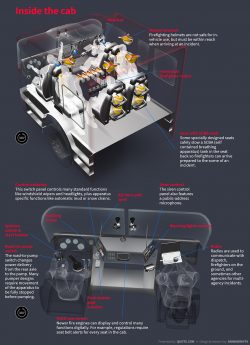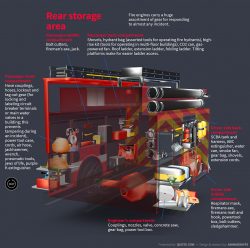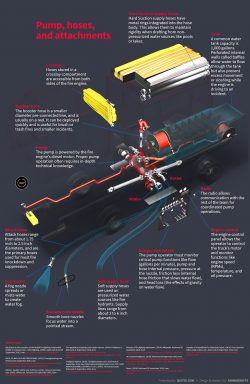Inside a fire engine
A fire engine (also referred to as a “pumper”) transports crew, supplies, and firefighting capabilities to the scene of an incident.
Warning lights
Upper level lights, like the light bar on the cab roof, are for long distance warning. Lower level lights on the sides, fenders, and bumpers are for close proximity warning.
Master stream
An engine-mounted master stream is capable of delivering huge amounts of water over long distances.
Hoses
Various diameters and lengths of hoses are stored throughout the apparatus.
Electronic sirens
The electronic siren uses a loud speaker to produce warning sounds.
Preconnect
A pre-connected hose reduces preparation steps at the scene.
Storage compartments
The apparatus has ample storage space for essential firefighting tools and implements.
Pump
The pump is powered by the diesel engine through the drive shaft.
Exterior paint
Retroreflective paint stripes on the sides and chevron markings at the rear are required by regulation. Retroreflective materials reflect light back to the source for high visibility.
Air horns
Air horns use compressed air to create a loud warning sound.
Federal Q siren
The Federal Q is a traditional electro-mechanical siren (sound is produced by an electrically driven metal rotor) that produces a characteristic “wail” sound. It’s controlled by a driver-side left foot switch in this instance.
Extended front bumper
Spacious front bumpers provide convenient access to essential tools and connections, especially in confined environments like small streets where only the front of the engine can face the scene.
Inside the cab
Headset
Helmet bracket
Firefighting helmets are not safe for in-vehicle use, but must be within reach when arriving at an incident.
Individual firefighter radios
Seat with SCBA tank
Some specially designed seats safely stow a SCBA (self contained breathing apparatus) tank in the seat back so firefighters can arrive prepared to the scene of an incident.
Control switches
This switch panel controls many standard functions like windshield wipers and headlights, plus apparatus specific functions like automatic mud or snow chains.
Air horn pull cord
Siren control
The siren control panel also features a public-address microphone.
Parking brake
Ignition switch & start button
Warning lights control
Road-to-pump switch
The road-to-pump switch changes power delivery from the rear axle to the pump. Many pumper designs require movement of the apparatus to be fully stopped before pumping.
Radio
Radios are used to communicate with dispatch, firefighters on the ground, and sometimes other agencies for multi-agency incidents.
Push button gear selector
Multi-use screen
Newer fire engines can display and control many functions digitally. For example, regulations require seat belt alerts for every seat in the cab.
Rear storage area
Fire engines carry a huge assortment of gear for responding to almost any incident.
Passenger middle compartment
Bolt cutters, fireman’s axe, jack.
Passenger back compartment
Shovels, hydrant bag (assorted tools for operating fire hydrants), high-rise kit (tools for operating in multi-floor buildings), CO2 can, gas-powered fan. Roof ladder, extension ladder, folding ladder. Tilting platforms make for easier ladder access.
Passenger front compartment
Hose couplings, hoses, lockout and tag out gear (for locking and labeling circuit breaker terminals or main water valves in a building; this prevents tampering during an incident), power tool case, cords, air hose, jackhammer, wrench, pneumatic tools, jaws of life, purple K extinguisher.
Driver side back compartment
SCBA tank and harness, ABC extinguisher, water can, smoke fan, gear bag, shovels, extension cords.
Driver side middle compartment
Respirator mask, firemans axe, firemans mall and hook, powertool box, bolt cutters, sledgehammer.
Engineer’s compartment
Couplings, nozzles, valve, concrete saw, gear bag, power tool box.
Pump, hoses, and attachments
Hard Suction supply hoses
Hard Suction supply hoses have metal rings integrated into the hose body. This allows them to maintain rigidity when drafting from non-pressurized water sources like pools or lakes.
Tank
A common water tank capacity is 1,000 gallons. Perforated internal walls called baffles allow water to flow through the tank but also prevent excess movement or sloshing while the engine is driving to an incident.
Crosslay
Hoses stored in a crosslay compartment are accessible from both sides of the fire engine.
Booster hose
The booster hose is a smaller diameter pre-connected line, and is usually on a reel. It can be deployed quickly and is useful for brush or trash fires and smaller incidents.
Pump
The pump is powered by the fire engine’s diesel motor. Proper pump operation often requires in-depth technical knowledge.
Outlet
Intake
Radio
The radio allows communication with the rest of the team for coordinated pump operations.
Attack hose
Attack hoses range from about 1.75 inch to 2.5 inch diameters, and are the primary hoses used for most fire knockdown and suppression.
Engine control
The engine control panel allows the operator to control the truck’s motor and monitor functions like engine speed (RPMs), temperature, and oil pressure.
Gauges and valves
The pump operator must monitor critical pump functions like flow (gallons per minute), pump and hose internal pressure, pressure at the nozzle, friction loss (internal hose friction that slows water flow), and head loss (the effects of gravity on water flow).
Soft supply hose
Soft supply hoses are used on pressurized water sources like fire hydrants. Supply lines range from about 3 to 6 inch diameters.
Fog nozzle
A fog nozzle spreads or mists water to create water fog.
Smooth bore nozzle
Smooth bore nozzles focus water into a pointed stream.
Sharing images
(click for large versions)




References
- BACK-TO-BASICS PUMP OPERATIONS. (2013). Fireengineering.com. Retrieved 26 September 2016, from http://www.fireengineering.com/articles/print/volume-154/issue-3/features/back-to-basics-pump-operations.html
- Elliotts - Quality Safety Gear. Articles, reviews, news, promotions, tips. (2016). Elliotts.net. Retrieved 26 September 2016, from http://elliotts.net/articlegroup/structural-firefighting-2
- Fire apparatus pumping: static water sources. (2016). FireRescue1. Retrieved 26 September 2016, from http://www.firerescue1.com/fire-products/fire-apparatus/articles/1913867-Fire-apparatus-pumping-static-water-sources/
- Firefighter Nation. (2016). Firefighternation.com. Retrieved 26 September 2016, from http://www.firefighternation.com/ FRC | SEAT MONITOR & WIRELESS VDR w / Lat G. (2016). Fireresearch.com. Retrieved 26 September 2016, from http://www.fireresearch.com/product.php?id=sba100
- Glossary of firefighting equipment. (2016). Wikipedia. Retrieved 26 September 2016, from https://en.wikipedia.org/wiki/Glossary_of_firefighting_equipment
- LA County Firefighters. (2016). Retrieved 26 September 2016, from http://lacountyfirefighters.org/images/shared/Apparatus_Operator/KME_Aerial_Manual/ASUB2_LACFFASSOC_2010_KME_AerialCat_Manual_Inside_the_cab.pdf
- Quora. (2016). Retrieved 26 September 2016, from https://www.quora.com/What-do-all-the-controls-on-a-fire-engine-truck-do
- Supplier of Preoxidized Fire Retardant Fabric. (2016). Fire-retardant-fabric.ready-online.com. Retrieved 26 September 2016, from http://fire-retardant-fabric.ready-online.com/fire-retardant-materials.html
